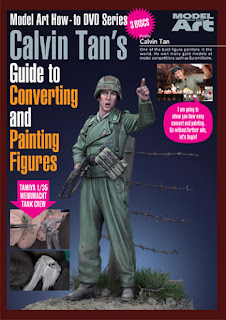Alpine Miniatures - Grenadier, 558. Volksgrenadier-Division, East Prussia 1945
.
Well finally after some anticipation, here are some previews of Alpine Miniature's latest 1/16 scale offering before it officially goes "live".
Now with regards to painting, I've always employed a method employed by legendary American illustrator Andrew Loomis called “toning” the palette. One of my favorite artist James Gurney summarizes this clearly HERE; which may I add contains a ton of other valuable knowledge which could prove extremely relevant for future projects.
As mentioned previously in my earlier post, I opted to employ a palette of cool colors to reinforce the portrayal of cold and darkness of twilight. Hence, the colors of the figure were not mixed to match the actual artifacts but instead to sync with the atmosphere. That is why it might not be a good idea to use my color notes to paint a paratrooper at Monte Cassino which might be sunny, hot and dry.
Again, with reference to the Impressionists, colors are no longer the intrinsic property of the object but rather by of the illumination of light making the appearance of its color a highly extrinsic one.
It might sound complicated from this point but I believe that this can have both intrinsic and extrinsic implications to the subject. Intrinsic meaning that the subject is illuminated with its own light rather than on an external source (the light which we rely for painting). Fantasy miniature artists have long understood this and have since exploited it to great extent in their works to depict atmosphere. David Rodriguez's excellent example greatly exemplifies this with his rendering of Gandalf.
For historical subjects, one work that comes to mind was the rendition of the bust from Benito of U-Boot commander Eric Topp, in which Spanish miniature artist Jose Caballero Delso brilliantly captured the illumination of the red light within the confines of the submarine vessel without it awkwardly looking like red paint being smeared. There is of course a principal to this method pioneered by Cezanne more than a century ago. I think I'll save the explanation for another painting project in the future.
.
cheers,
Calvin



















10 comments:
Great painting on a great sculpt!
again dreamteam TS and CT!
how do you like vallejo gamecolor so far?Any particular reason that youre using them?
best Regards
Andreas:-)
nice!
what colour do you use to paint steel helmets?
Thanks for sharing Calvin your thoughts on artistic style and influences. I've visited each of the links provided and will be sure to browse more fully those Andrew Loomis articles. James Gurney's point about seeing the individual toned figures\images side by side makes one appreciate the toned palette. Otherwise it can be lost. I too like to create and atmosphere that suits the figure but missed the subtlety of how to do this until I read your post.
Kind regards,
Mike
Thanks again for the kind support. I'm glad that some of you have found this interesting (not that it is an orignal thing really but really something that has gone quite unoticed for the longest time).
Andreas, reason for using the Vallejo Game colors is such that I could work with color hues rather than just color shades and tints. Most colors used were not straight from the bottle but carefully mixed from primary and secondary colors. This produces different qualities of hues for shading instead of just darkening or lightening one color source of the local color.
I know that this sounds like a lot of information and I do think that it does warrant a more detailed article for a full explaination.
Oliver, the colors I used for the helmet were mixed from black, Prussian blue and orange. I varied the proportions of each color mixed to attain several variations of hues which helped to give greater color intensity. The shadows were also washes of very dark blue and purple instead of black.
Calvin
You make it seem to easy and then when I am sitting at my desk working, I can never ever come close to your results. You did an awesome job!!!!!And thanks for the info you provide with each figure.
thanks calvin, i've always liked the way you paint german helmets.
Do you have a link to that erich topp figure? I'd really like to see it.
Impressive work Calvin... I'm just in the middle of painting splinter camo on the 120mm S&T Unteroffizier and your paintwork is very inspirational. Can you share the technique on painting rain marks (splinters) with me? I was considering several different options, but it all seems nerve wrecking and time consuming. My best idea was to produce some sort of a "jig" and press the splinters onto the pattern... of course, working one bit at a time.
Mario
Amazing work as Allways Calvin, I love it!!
Luis
La Paz, Bolivia
Hi Mario,
no special tricks or methods to paint the lines I'm afraid. Just a lot of patience and a steady hand.
Calvin
Thanks Calvin... after trying all sorts of different techniques I also found out there's nothing better than a good brush and a steady hand. I would appreciate your thoughts if you have the time to check out my figure on TimeLines forum:
http://www.timelinesforum.com/forums/showthread.php?t=8608
Thanks,
Mario
Post a Comment